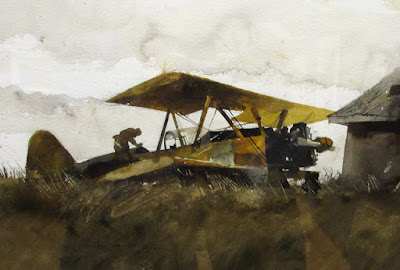 |
| Andrew Wyeth, Rockland Harbor, 1954 |
 |
| Wyeth, detail of Harjula's Airport, 1964 |
Wyeth takes great care in drawing and perspective, but he's very selective, focusing only on the part of the scene he wants to show. This biplane is only a small area of the overall composition, and it is carefully observed but efficiently described.
Here's a detail of "The Slip," showing a two-masted schooner in dry dock, surrounded by grass. The painting is listed as a "drybrush watercolor," a term popularized by the Wyeths to include some opaque white gouache passages. The term is a little misleading, because the pigment isn't necessarily applied dry.

There's also an exhibition called NC Wyeth: Poems of American Patriotism at the nearby Wyeth Center, part of the Farnsworth Art Museum.
-----
Museum website: Andrew Wyeth in Rockland through February 17, 2019.
Online article: Andrew Wyeth's Rockland: Boats, Planes, and Trains
Recommended books:
Andrew Wyeth: Looking Out, Looking In
Andrew Wyeth: A Secret Life
Andrew Wyeth, Christina's World, and the Olson House
Andrew Wyeth: A Spoken Self-Portrait














































